A Month Of Trucking With Daniel B.
Topic 6390 | Page 15

On the morning of the 29th you said
I start my day at 0730. Before I drive I drain my air tanks.
I was wondering when I was reading through The High Road Training Program why it states that air tanks should be drained at the end of each day. Is there an advantage to waiting until the start of a new day to do this?
I can think of pros and cons for both arguments such as:
1) Typically evenings are cooler and the chances of any water freezing in the lines would be greater, so better to drain it before it has the chance to freeze.
2) On the other hand it makes sense to me as well that I would want the driest air possible in the lines just prior to rolling out for the day.
3) But there's also the logic that given the fact you are that far north and it's basically the middle of winter and temperatures are below freezing, no matter what time of day it is, who cares as long as the tanks get drained once a day.
Your thoughts. Longer question than an answer I would suspect lol.
CDL:
Commercial Driver's License (CDL)
A CDL is required to drive any of the following vehicles:
- Any combination of vehicles with a gross combined weight rating (GCWR) of 26,001 or more pounds, providing the gross vehicle weight rating (GVWR) of the vehicle being towed is in excess of 10,000 pounds.
- Any single vehicle with a GVWR of 26,001 or more pounds, or any such vehicle towing another not in excess of 10,000 pounds.
- Any vehicle, regardless of size, designed to transport 16 or more persons, including the driver.
- Any vehicle required by federal regulations to be placarded while transporting hazardous materials.
12/30
I didn't sleep well at all. I don't know why but I woke up like a dozen times for no reason. Based on my memory, every time I woke up I opened the curtains to look outside. And every single time I remember seeing snow on the ground.
I woke up early this morning at 0330 and there was not a single flake of snow on the ground. Have I gone mad? I think Montana did some permanent damage. No really, I've seen so much snow lately that I'm waking up in bed and hallucinating seeing snow on the ground? Seriously, what the heck!
Whenever I have repeated 3,000+ mile weeks I frequently wake up at night thinking the truck is rolling. I frequently have dreams where I am driving the truck while I'm sleeping. Many times I wake up feeling like I'm moving but no one is at the steering wheel. I've had a dream that I woke up from a dream and the truck was driving and I jumped up to drive it because it was starting to drive off the road. Also have had dreams where the truck is going down a grade out of control and I would pump my right foot to try and slow it down. Other times I dreamt that the truck was moving and I tried to steer it except the blinds were down so I was steering it but couldn't see anything.
Those dreams don't happen much. But I do get up from my sleep every once in a while because I feel like the truck is coasting, so I get up and check that we're still in the same spot that I parked.
I know I'm not the first one to have dreams like this because we actually had a discussion about this and several people told their stories. But this waking up to no snow when I saw snow is something new to me.
Strange night, time to move on and forget about my hellish experience in Montana. Apparently it has scarred me.
I drove for under 2 hours and got to my delivery facility at 0540. 20 minutes early, I'll take it. Honestly, they're damn lucky to get their freight on time. This load was way too tight considering what I had to go through and should have been rescheduled. But I took it here and didn't complain to anyone. The secret to becoming your fleets top tier driver is getting it done safely and on time, being reliable and always a professional with a great attitude.
Here is my local directions macro. Its a bit unusual as you can see. No parking on streets means that this place isn't in a truck friendly zone, and having to sit in the middle of the road for them to come and get you tells me that their facility is so small it can't house a truck waiting to get a door. I've never been here and so far it looks bad.
A lot of these local directions list multiple ways to get to the facility based on which direction you're coming from. Since I'm coming from I90, I need to follow the second set of directions. Since the directions are slightly confusing I will translate monkey language to you again.
From I90, Take I405 South to Exit 2A (WA 167 South). Exit 43rd Street at End Of Ramp (EOR) Turn Left at 43rd Street. Then Turn Right. Go West over 2 RailRoad tracks and turn Left on 72nd Ave, Customer on Left.
Remember the monkey code! Everything is abbreviated, misspelled, or written by a monkey. Its your job to translate the monkey language into English and follow the route. These directions, when translated back into English, are always accurate but do keep your eyes peeled- don't just follow it blindly.
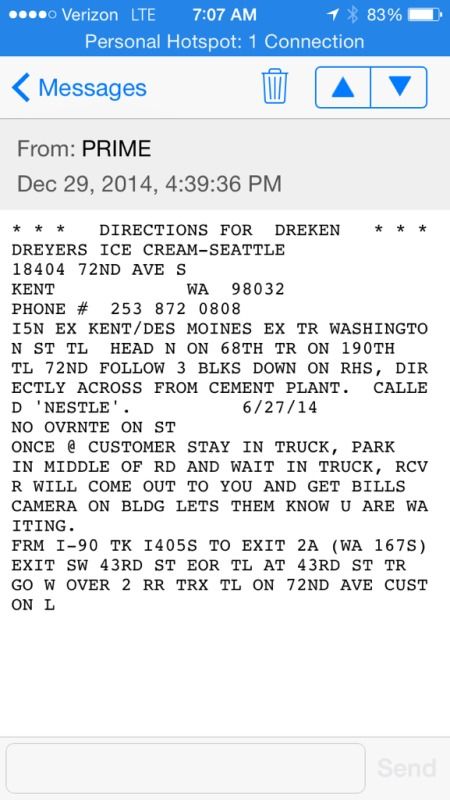
Next step, Google Earth the facility. We don't know what we're dealing with here so its best to come as prepared as possible. Here is the facility. Also, here is how the backing went.
Yellow - Parking.
Red - Forward Motion.
Blue - Backing.
That's a very safe backing, wouldn't you agree? What a joke. This street is pretty busy so as expected, I held up both sides of traffic. There wasn't enough room in the facility to make a U-Turn inside. A lot of these shippers/receivers advertise just how safety concerned they are but then they make drivers do these types of maneuvers.
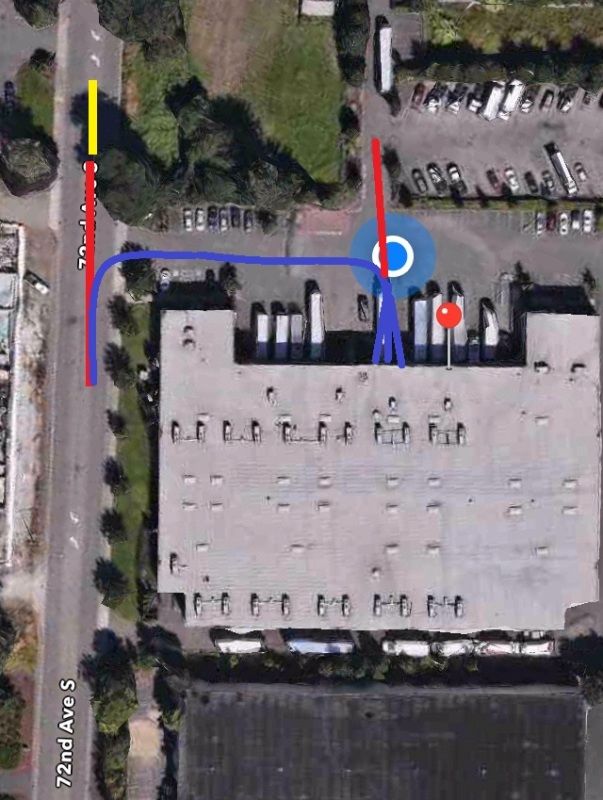
Shipper:
The customer who is shipping the freight. This is where the driver will pick up a load and then deliver it to the receiver or consignee.
HOS:
Hours Of Service
HOS refers to the logbook hours of service regulations.12/30 Continued...
And as my local directions macro commanded me, I parked in the center of the street between the yellow lines and waited.. and waited... and waited. Its now 5 minutes until my appointment time and still no one to be seen. So I have a choice to make.
Do I:
A. Continue sitting as instructed to risk not "getting in trouble".
B. Go walk around and find someone to talk to.
I chose B. So I got out and walked around the facility and finally found an entrance. Talked to the guy and he directed me to dock #7. I did my backing as mentioned above and didn't hit anything. That's always a pat on the back for me!
You shoulda seen me opening my trailer doors. The back of my trailer didn't look any better than the picture I posted above. I opened the trailer doors so cautiously and staring up into the sky making sure that no dirt snow is going to fall on me. It took about 2 minutes to open my door because as soon as I tried to open them it started showering me with that dirt. That stuff was disgusting, and I sure made a mess in the lot at my customer. It was funny, even for me.
They didn't take long to unload me, just over an hour. You won't believe what I did when I got unloaded. I call this "Being a step ahead of dispatch", in other words, predicting my next pickup. Now you're probably sitting there thinking that I'm crazy, and you're right, but doing this can really put you ahead of schedule - or it can put you behind schedule. I seriously don't recommend you do what I'm about to describe but when you learn your companies freight lanes well enough you can win at this gamble.
I Off-Duty drove to the TA right below Snoqualmie Pass (East of Seattle). What was I doing? I was predicting a pickup somewhere in the Eastern side of WA. I used Off-Duty time legally to drive to my predicted pickup without using my driving time. My Off-Duty Driving was totally legal because I wasn't under a load and had no freight in my trailer. Though I was using it specifically to get closer to my predicted pickup location, that's not breaking the rules, that's bending the rules.
I went 45 miles towards Eastern WA and then I get my load. Let's see if my gamble paid off. If it did, I just drove 45 miles without using my clock. If its going to backfire, then I have to retrace my steps.
Drum Roll!!!
Next Load:
Pickup: Kennewick, WA App Time: 12/30 @ 2100
Destination: Milpitas, CA App Time: 01/01 @ 2359
Awesome! My gamble was a great success. Man, I predicted my next load and saved a bunch of driving time off my clock. That's how I roll! This load is my load thats taking me home. So just one more and I'm home for four days.
While parked at the TA I swept my trailer and drained my air tanks. I left and headed straight to my pickup and arrived at 1300. An entire 8 hours before my appointment time. I called my shipper and as always, they can't load me early. So I drove to a truck stop 1 mile from my shipper and parked there for the afternoon/evening. I did a total of about 320 miles today in a 9 hour day.
Shipper:
The customer who is shipping the freight. This is where the driver will pick up a load and then deliver it to the receiver or consignee.
HOS:
Hours Of Service
HOS refers to the logbook hours of service regulations.Next step, Google Earth the facility. We don't know what we're dealing with here so its best to come as prepared as possible. Here is the facility. Also, here is how the backing went.
Yellow - Parking.
Red - Forward Motion.
Blue - Backing.
That's a very safe backing, wouldn't you agree? What a joke. This street is pretty busy so as expected, I held up both sides of traffic. There wasn't enough room in the facility to make a U-Turn inside. A lot of these shippers/receivers advertise just how safety concerned they are but then they make drivers do these types of maneuvers.
This looks familiar , I think I delivered there with swift when I drove for them....
Shipper:
The customer who is shipping the freight. This is where the driver will pick up a load and then deliver it to the receiver or consignee.
On the morning of the 29th you said
I start my day at 0730. Before I drive I drain my air tanks.
I was wondering when I was reading through The High Road Training Program why it states that air tanks should be drained at the end of each day. Is there an advantage to waiting until the start of a new day to do this?
I can think of pros and cons for both arguments such as:
1) Typically evenings are cooler and the chances of any water freezing in the lines would be greater, so better to drain it before it has the chance to freeze.
2) On the other hand it makes sense to me as well that I would want the driest air possible in the lines just prior to rolling out for the day.
3) But there's also the logic that given the fact you are that far north and it's basically the middle of winter and temperatures are below freezing, no matter what time of day it is, who cares as long as the tanks get drained once a day.
Your thoughts. Longer question than an answer I would suspect lol.
Great question I wish more of you guys would ask these kinds of questions. Draining the tanks is something you cannot do too often. Personally every time I walk around the truck I drain it just for a second or two to try to get some moisture out. But draining the tanks, the more you do it the better off you'll be. I like to drain them at all times of the day.
CDL:
Commercial Driver's License (CDL)
A CDL is required to drive any of the following vehicles:
- Any combination of vehicles with a gross combined weight rating (GCWR) of 26,001 or more pounds, providing the gross vehicle weight rating (GVWR) of the vehicle being towed is in excess of 10,000 pounds.
- Any single vehicle with a GVWR of 26,001 or more pounds, or any such vehicle towing another not in excess of 10,000 pounds.
- Any vehicle, regardless of size, designed to transport 16 or more persons, including the driver.
- Any vehicle required by federal regulations to be placarded while transporting hazardous materials.
12/31
I picked up my load last night and all went well with that. This load is 45,400 pounds of French Fries. That's a lot of modified potatoes!
Today is my last update unfortunately. Its also my last long day before I go home. Needless to say, I just want to get it over with so I can go home already. Its been a long, dangerous, frustrating month and I need a break.
I wake up at 0630 and started driving immediately. But before you drive, you need to do a Pre-Trip Inspection. When I did my walk around, I discovered this.
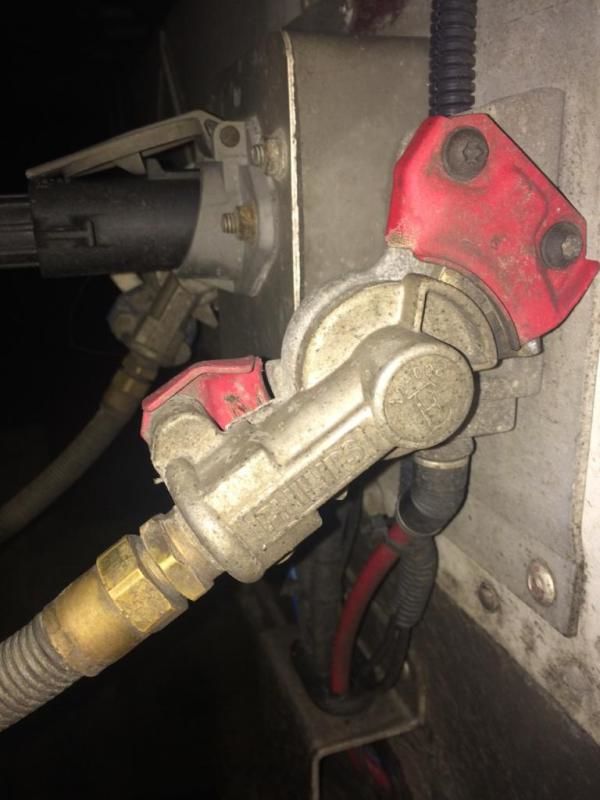
That is the red air line that supplies air to the trailer. It was half off. Guess what happens when the trailer stops receiving air from this air line? The trailer brakes engage. So I would have been driving down the road at 60mph and all my tires would have locked up on the road while in motion. I would have either gave the tires a giant bald spot, or I would have popped all 8 tires. Either way, this could have been an accident and if those tires popped it would have probably went on my record as a preventable incident.
That folks, is the importance of an inspection. I can't tell you how hard it is to keep your record clean. A small mishap like this could cost you everything. I don't know how it was half off. Personally, I think I unknowingly ****ed someone off yesterday or someone has a grudge against my company so they wanted to exact revenge by doing this. You can bet I inspected everything else extra well today to make sure nothing else was done.
Today I will have breakfast with my old trucker buddy TSB. Anyone who has been on TT knows who he is. He is Starcar's husband and a 43 year trucking veteran. Starcar talked a lot about him and I am very good friends with him. Whenever I'm in the area we meet up at the truck stop and talk trucking for an hour or two. He's a very interesting guy and has been through a lot. He is from the trucking era where they used drugs to keep themselves awake, he also ran three log books and was an "outlaw" trucker. Man, have the times changed.
This is a picture of me and him when we met up with Starcar back when I had my old truck.

And to anyone who has been a TT'er for a while, you know that Starcar and TSB owned their own truck and trailer. This is the truck he owned and currently still drives it. 18 speed, CAT engine, extended-hood Western Star.
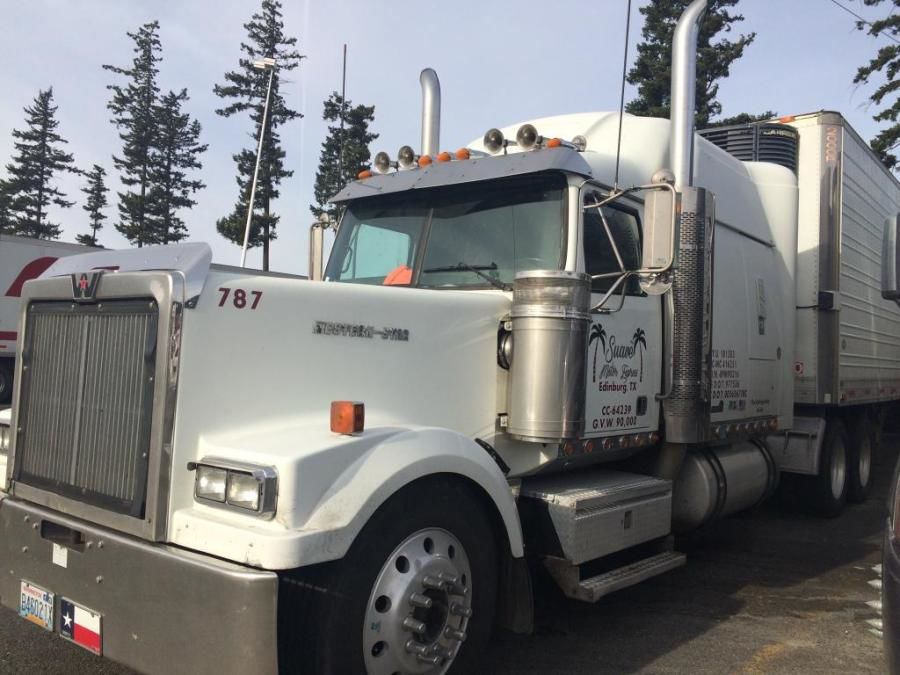
Man, I love meeting with friends out on the road. Earlier this month I've also had the chance to meet Old School again.
After my breakfast with the trucking legend, I hit the road again. The roads were nasty in some areas but I was loaded extremely heavy and had plenty of traction the entire drive.
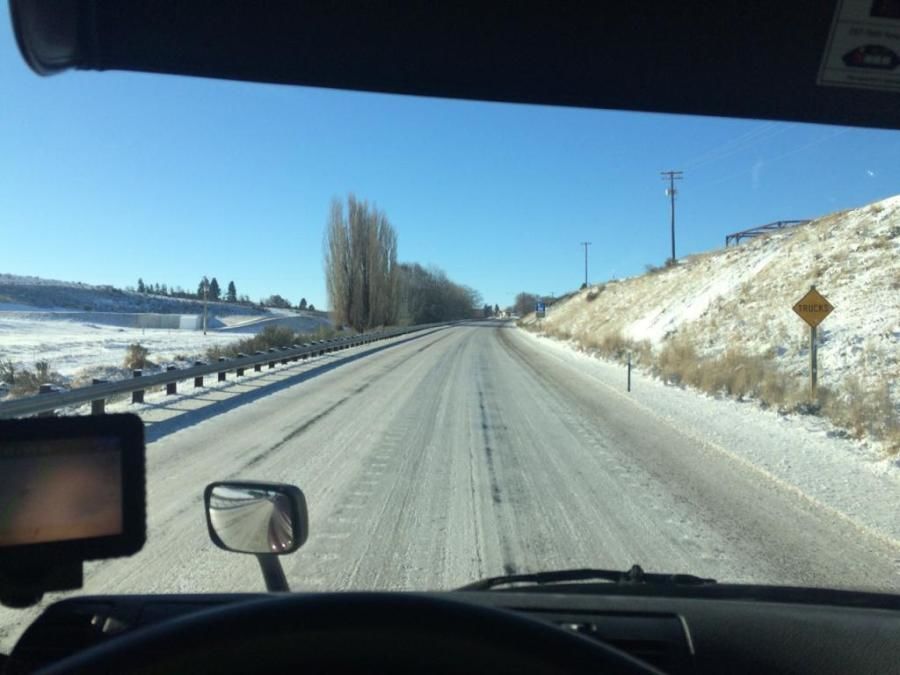
To anyone starting trucking in the winter, you'll face these type of roads often. Just take it slow and don't do anything abruptly, listen to your trainer and if you ever doubt the validity of his teachings send me a private message and I'll clear the air. Remember, I'm here to help you guys and I'm literally one click away. So just because this thread will be over doesn't mean I'm retiring. Though, if Brett lets this thread get lost in the pages like all my other good threads then I just might! Hehe.
The drive wasn't too special. Just lots of mountains and curves. I took a 30 minute break at a Pilot along the way and during that break I cleaned my windshield and refilled my washer fluid and also changed my wiper blades. A break is hardly ever an actual break.
Listen, these Driver Managers get bombarded with upset drivers and complainers all day long. My Driver Manager has 75 drivers, with that many drivers there's bound to be several people upset or complaining to him. The way you treat your Driver Manager will have a gigantic influence on your success. So its always a good idea to make your Driver Manager smile and let him know you appreciate him.
I sent this to my Driver Manager:
"Goodmorning sir! Man, that was a wild ride through Montana! Thank you for running me and keeping me busy. You're great to work with!!"
Nice, simple, and to the point. That Montana load was way too dangerous and way too tight scheduled, but instead of complaining, I just complimented him. Learning how and when to talk to your Driver Manager will go a long way.
He replied:

Perfect! I made him smile and he told me that I'm doing good too. You can tell a lot about how your Driver Manager views you by his replies to these types of messages.
Who doesn't love compliments? Be a profession, reliable, and always have a great attitude with everyone - especially your Driver Manager. Please take what I've taught you on the road and use it well.
I ended my day today just two hours from the house. I'm going to stop by the house tomorrow in the morning and then deliver my load, then go home for 4 days. I'll be adding more content tomorrow, but no day-to-day updates! Stay tuned, good stuff coming!! : D
Pre-trip Inspection:
A pre-trip inspection is a thorough inspection of the truck completed before driving for the first time each day.
Federal and state laws require that drivers inspect their vehicles. Federal and state inspectors also may inspect your vehicles. If they judge a vehicle to be unsafe, they will put it “out of service” until it is repaired.
Dm:
Dispatcher, Fleet Manager, Driver Manager
The primary person a driver communicates with at his/her company. A dispatcher can play many roles, depending on the company's structure. Dispatchers may assign freight, file requests for home time, relay messages between the driver and management, inform customer service of any delays, change appointment times, and report information to the load planners.Driver Manager:
Dispatcher, Fleet Manager, Driver Manager
The primary person a driver communicates with at his/her company. A dispatcher can play many roles, depending on the company's structure. Dispatchers may assign freight, file requests for home time, relay messages between the driver and management, inform customer service of any delays, change appointment times, and report information to the load planners.HOS:
Hours Of Service
HOS refers to the logbook hours of service regulations.OWI:
Operating While Intoxicated

Hey Daniel. Do you happen to be a trainer at prime?
Hey Daniel. Do you happen to be a trainer at prime?
Daniel quit training as he was begaining to get grey hair .. lol

Hey Daniel. Do you happen to be a trainer at prime?
Daniel quit training as he was begaining to get grey hair .. lol
That's to good. Lol
New Reply:
New! Check out our help videos for a better understanding of our forum features

















Preview:
This topic has the following tags:
Advice For New Truck Drivers Cooking In The Truck Food & Eating On The Road GPS Systems Home Time Life On The Road Logbook Questions Time Management Trip Planning Truck Driving Lifestyle Truck Driving Stories Trucker's Family Matters Winter Driving Tips







 TT On Facebook
TT On Facebook
You know Daniel your entry pictures into Idaho remind me of the days when i lived there at the very top of the state about 25 miles south of the Canadian Border. Very beautiful but dangerous weather and road conditions in the winter. Safe travels and look forward to reading your daily adventures. You mentioned leaving? If so wherever your next job is good luck. I was hoping you would take me as your next trainee. I start with Prime on the 5th. You would have a lot to offer a student based on your experiences and what i have read here.